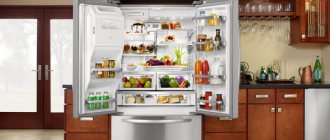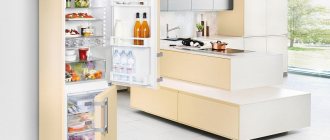The refrigerator is the most necessary household appliance in the house. If it fails, then whether you want it or not, you have to buy a new one. The choice is now huge - from models that are built-in to standard ones, with different designs and functionality. Before purchasing, a completely logical question arises: what is the difference between built-in equipment and conventional equipment, and which option is preferable?
Built-in refrigerator
General characteristics and functions
Before moving on to the differences between built-in and conventional technology, let's consider their common basic functions:
- Volume. This is one of the most important parameters. The refrigerator must first fit through all doorways and then hold the right amount of food for the entire family.
- Power. The level of energy consumption and the intensity of cooling of products depends on this. Currently, manufacturers are trying to reduce this indicator by all possible methods, from increasing efficiency through the use of other types of compressors, to improving the thermal insulation properties of the housing. The latter helps keep food cold when the compressor is idle and switched off.
- Freezing method. Over the past 5 years, dry freezing has become the most popular - this technology is called “No frost”. Depending on the manufacturer, the name may sound different, but the essence remains the same. Its main feature is the absence of ice on the products and in the chambers, so such refrigerators do not need to be defrosted. In addition, it is convenient to freeze fruits and vegetables for the winter; according to forecasts, No-Frost will soon simply force competitors out of the market. There are other types of freezing, for example, drip freezing, where drops of condensate flow down the back wall and an ice crust gradually forms.
Features of built-in refrigerators
In stores, among the variety of household appliances, you can find faceless built-in refrigerators with various fasteners on the facade. But in the end you will get the design you need.
Built-in refrigerators are mounted in furniture. This is convenient no matter where it is located - in the kitchen, in the hallway or in any other room. Thus, you completely hide the refrigerator from view and visually increase the space of the room.
The next important factor is that built-in refrigerators are less noisy. Noise reduction is achieved precisely due to the fact that the refrigerator is placed in furniture and is partially isolated from the outside world. Some vibrations are dampened by the design of the cabinet or cabinet in which it is located.
Built-in refrigerator at home
The built-in version is no different from the usual one inside. But from the outside, the impression of an unfinished device is created - the facing panels are partially missing, and fastening elements are located in their place. With their help, the refrigerator door is connected to the doors of the furniture in which it is built. Therefore, you can give any appearance to your refrigerator even long after purchase.
Attention! The cabinet for installing a built-in refrigerator should be larger than the device itself by about 10 cm on each side in width and 25 cm in height and 5-10 in depth. The exact distances will be indicated in the instructions for the refrigerator.
To ensure that when the cabinet doors are opened, the refrigerator door opens with it, sliding or hinge fasteners are used. Otherwise, you will first open the cabinet door and only then the refrigerator door - this is inconvenient.
However, there are other nuances:
- Make sure in advance that there is an outlet in the place where the device will be installed. It will not be very convenient to install an extension cord in an already installed set of furniture. By the way, if necessary, it is convenient to use broaches made of thin cords or wire.
- Moving integrated household appliances is very problematic, especially if the furniture is not of the same type and its design changes depending on its position in the corners, in the center, etc. Therefore, the decision to purchase it must be made at the stage of designing the future interior.
- The cabinet should not be dull. The principle of operation of the refrigerator is that the food gives off heat to the refrigerant, which flows through a system of tubes located inside the device. This heat needs to go somewhere - it goes into the environment. If you install the refrigerator in a confined space, it will overheat. Therefore, the cabinets must provide the possibility of installing built-in equipment and ventilation of the rear wall (or lack thereof).
Which built-in refrigerator is better to choose?
Built-in refrigerators have a lot of differences between them, convenient for one or another user.
Let's take a closer look. For lovers of an improved interior, two types of controls are offered. The electromechanical type involves regulating the temperature in the compartment based on the temperature of the highest level of the cold point on the evaporator. The electronic type, equipped with a touch control system with a keyboard and having a pleasant aesthetic appearance, regulates the air temperature inside the chamber using sensors. Although the electromechanical one has a reputation for being more reliable and easier to use, it is not able to set exact numbers for cooling, only approximate ones (unlike electronic control).
You also need to pay attention to the compressor. The inverter type is considered more durable, in which electricity consumption and noise are reduced to a minimum. In addition to long-term storage of food freshness, it functions constantly at the set temperature. There is also a conventional compressor, which, having reached maximum cold power, turns off for a while, and then returns to work again.
The device can have energy efficiency from class A to G. When choosing, you should evaluate the low energy consumption of class A: the more “+” prefixes, the better.
The brands that are considered the best selling and have received more laudatory reviews compared to other manufacturers are: Bosch, Hansa, Liebherr, Siemens, Samsung, ATLANT, etc.
Advantages and disadvantages of built-in models compared to conventional ones
It is quite difficult to compare conventional refrigerators with built-in ones. The fact is that both options can be matched to the kitchen design and certain advantages can be found. But let's take an objective look at the advantages and disadvantages of each type.
Advantages of built-in refrigerators:
- Versatility. The lack of connection to the design allows you to install it anywhere, even in the closet in the bedroom, no one will understand that there is a refrigerator there.
- Space saving. The equipment built into the furniture allows it to be used, while combining the point of its installation with an area for storing something, or for other functions.
- The wide range of models on the market will allow you to integrate the refrigerator into any bedside table.
Flaws:
- Built-in models have a slightly higher price than regular ones.
- Difficult to move after installation.
- It is necessary to lay the cable exactly in the place where the device will be installed.
- During repairs, problems will arise in approaching the unit from the side of the faulty unit.
- If you want to buy another refrigerator, you may have problems selecting a model with similar dimensions.
Advantages of conventional refrigerators:
- It is easier to find a suitable option in almost any store. They are more common.
- The cost is slightly cheaper than built-in ones.
- Easy to move or move to another room.
- It is easier to localize and get to the fault during repair.
Flaws:
- If you have made repairs and the model does not fit into the interior, you will either have to put up with it or buy a new one.
Regular refrigerator
Built-in refrigerator
Differences and similarities
To an inexperienced buyer, it may seem that these two types of refrigerators differ only in the ability to build them into a kitchen niche or other furniture. But there are a number of other differences.
Built-in
The appearance of the built-in refrigerator attracts attention - the unit is easily disguised with decorative panels, blends into the interior and can be a successful design solution. However, the technical characteristics also differ.
Main features of built-in refrigerators:
- additional ventilation;
- reinforced heat-insulating layer;
- increased safety requirements;
- silent operation.
With the same dimensions as conventional models, the working volume of the internal chambers of built-in equipment will be approximately 15% lower due to design features. On average it is 200-250 liters, but there are also larger models - up to 500 liters. For an office, cottage or small studio, compact equipment with a volume of about 100 liters is suitable.
Based on their layout, the following types of built-in refrigerators are distinguished:
- Single chamber - the refrigerator and freezer sections have only one door.
- Two-chamber - two doors, the freezer is located at the top (“Asian version”) or at the bottom (“European version”).
- Parallel or side by side - both compartments are located next to each other on the same level.
- Three-chamber - there is another section with a temperature of about 0°C, also called the “fresh zone”. It has a separate door.
You can integrate a refrigerator into the interior of the room in different ways. A special niche is created in the kitchen unit, where appliances are mounted to save space. Fans of more original solutions do not limit themselves to this, but disguise the doors of the device with panels. It is technically possible to build it into any furniture, cabinet or box; you can even give the refrigerator the appearance of a countertop.
Ordinary
The types of refrigeration units can vary greatly. The standard design gives less scope for experimenting with interior design and sometimes takes up a lot of space in the room. However, the maximum possible volume of a conventional unit is much larger - outside the kitchen it does not always look aesthetically pleasing, unlike its built-in counterpart.
comparison table
| parameters/type | recessed | ordinary |
| working volume | less | more |
| efficiency | higher | below |
| noise | less | more |
| price | higher | below |
| repair | more difficult | easier |
| installation | more difficult | easier |
| aesthetic design | higher | below |
The main differences between built-in and conventional refrigerators
Let's figure out whether built-in refrigerators are so different from ordinary ones in practice, comparing them according to a number of criteria.
- Appearance.
It will take a long time to choose a regular refrigerator so that its lines and shapes fit into the design of the room, and the handle is stylish and comfortable for you. Also, the color options of most models are limited to basic colors (white, stainless steel, gray and the like). Therefore, in a bright room it may look ridiculous.
Built-in models of any household appliance are chosen simply by their internal structure, number of shelves and volume. You create the appearance yourself when ordering a set of furniture.
- Functional.
Both built-in and regular copies can have any functions inherent in this type of technology. The price segment and the manufacturer’s policy play a decisive role here.
- Accommodation.
You can rearrange a regular refrigerator at any time, while a built-in one should be located inside the furniture. Therefore, its placement needs to be thought out in advance.
- Price.
Built-in models often cost a little more than regular ones. However, there are always exceptions to the rules and it may be that a regular model is several times more expensive than a budget built-in one.
Despite the obvious differences, behind them lies the not so obvious question of the device’s maintainability. It’s no secret that domestic power grids are not famous for their quality and voltage stability. Therefore, household appliances are always at risk. So, you can easily turn an ordinary refrigerator the right way around so that the technician can repair it. The built-in model will have to be removed from the place where it is installed - this is an extra waste of time, and possibly money.
What does a built-in refrigerator look like?
You can find a built-in built-in refrigerator in a kitchen only by the size of the furniture doors, although in many kitchen designs large appliances are replaced with 2 separate appliances: a refrigerator and a freezer.
To install a built-in refrigerator, order or buy a ready-made cabinet with a niche according to its dimensions and sufficient ventilation. Decorative panels are connected either rigidly or through sliding fasteners to the doors of the device and do not differ from the details of the façade of the rest of the set. As a result, the built-in refrigerator looks like a main cabinet.
Noise level
All types and models of refrigerators have the same drawback - they are noisy. The question is how much. The noise level depends on a number of factors:
- Compressor type.
- Conditions of compressor parts.
- How level is the refrigerator?
- On the level of vibration and noise insulation of the device as a whole.
- From the design features of placement and fastening of the compressor.
Conventional models are not in any way isolated from the environment, but built-in ones are closed with an external casing, which, if properly mounted and installed, will reduce its overall noise level.
Important! It is worth noting that now almost all household refrigerators operate quietly, and most conventional models do not cause discomfort, even if they are located in the room and not in the kitchen.
Refrigerator: built-in or free-standing?
Nowadays, such a household device as a refrigerator is, as you know, an integral part of any apartment or country house. For most of us, purchasing a refrigerator, for example, from an online household appliances store is a serious purchase that is not made every day. That is why the issue of choice in this case must be approached as responsibly as possible.
Modern manufacturers offer customers a wide range of household refrigerators, all models of which can be divided into two large groups: built-in and free-standing. What type of refrigerator should I buy? What are the advantages and disadvantages of built-in and free-standing models? What criteria should you pay attention to when making a choice? It’s worth figuring everything out in order.
Main features of built-in and free-standing refrigerators
The main difference between these types of equipment lies, of course, in the design features:
- Built-in models do not have an external casing; they are mounted in a cabinet in the kitchen or other room. The role of the body in this case is played by decorative panels.
- Free-standing refrigerators are independent devices that can be installed anywhere (of course, taking into account the configuration of the room and interior design).
In addition to the design features and installation method, built-in and free-standing refrigerators have the following differences:
- Built-in kitchen appliances are more ergonomic and allow you to save usable space.
- The panels that cover built-in refrigerators provide additional heat and sound insulation.
- Built-in refrigerators are not tied to the interior design of the kitchen, while when purchasing a free-standing model, you need to make a choice so that the appearance of the equipment matches the design of the room.
- A freestanding refrigerator, unlike a built-in one, can be moved freely around the kitchen.
It is possible to highlight a number of characteristics that unite both types of devices:
- Both built-in and free-standing refrigerators are used for long-term storage of chilled and frozen food.
- There are both single- and double-chamber refrigerators of each of the types under consideration on the market.
- Refrigerators of all types are divided into several groups according to such criteria as efficiency (energy saving) class. Manufacturers today create models with classes from G (the least energy efficient) to A++ (the most economical).
- Refrigerators of all types have modern defrosting systems (No Frost, semi-automatic and drip).
Price categories for built-in and free-standing refrigerators
The vast majority of manufacturers currently produce both built-in and free-standing refrigerators. It is typical that built-in devices, as a rule, cost slightly more than free-standing models.
The wide range of refrigerators offered by modern manufacturers includes devices in different price categories: from the most affordable to expensive ones, which can be classified as elite. The first include many models from such well-known companies as Freestanding refrigerator Bosch, Siemens and some others. Two-chamber refrigerators in this price category cost from 15 thousand rubles. Elite built-in devices and free-standing models are produced by such manufacturers as Miele, Kuppersbusch, Liebherr, Gaggenau, etc. Equipment of this class can cost 80, 100, 120 thousand rubles. and more.
The cost of a refrigerator depends on a number of factors. First of all, it is determined by the degree of functionality of the device, its ease of use and environmental friendliness. In addition, the price depends on the design of the equipment.
Top 5 tips for choosing a refrigerator
As a result of analyzing reviews of different models and communicating with experts, we have selected 5 tips on what to look for when choosing between a built-in and a conventional refrigerator:
- For those who are making major renovations with possible redevelopment, pay attention to built-in refrigerators, because they are convenient to hide in niches and cabinets. This way you will expand the usable space.
- If you need universal appliances, then a regular refrigerator is better suited for this. It is not picky about the installation location.
- If you want your refrigerator to attract attention, hiding it is the best option. In this case, choose built-in models. Also, built-in appliances are well suited for use in offices and other public eating places - they are not conspicuous and do not spoil the official style of the room.
- And for creative individuals and lovers of rearrangements, an ordinary refrigerator will be a salvation when they again want to start living in a new way.
- If the budget for purchasing a device is limited, it is better to spend money on a good model of a regular refrigerator from a trusted brand.
Watch a video about installing a refrigerator
How to choose
The specificity of choosing a built-in refrigerator is due to the fact that it is intended for installation in a cabinet, cabinet or behind decorative panels.
Pay attention to the characteristics:
- dimensions (height, width, depth and volume values must correspond to the parameters of the kitchen unit, otherwise installation will become impossible);
- number of cameras;
- installation features;
- door hanging mechanism;
- number of doors (refrigerators with several chambers are equipped with one door or separate doors for each chamber);
- energy consumption (the lower the energy consumption indicator, the better);
- presence and location of the freezer;
- defrosting system device;
- additional functions;
- compliance of the class of equipment with the class of the kitchen (this point will help to avoid inconsistencies and damage).
Pay attention to the country in which the equipment was assembled. Immediately after delivery, make sure the equipment is working properly.
When working with each characteristic and making a choice, consider your needs:
- how much food do you store in the refrigerator,
- How long have you been using the purchased equipment?
- Do you need a spacious freezer?
- Are additional functions needed?
- Will you be able to provide maintenance, spare parts and troubleshooting in the event of a breakdown?










